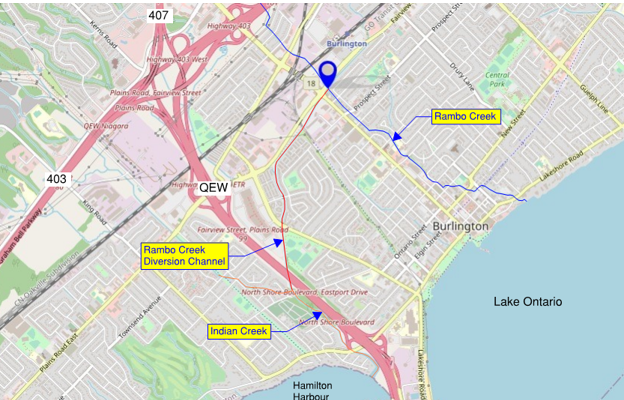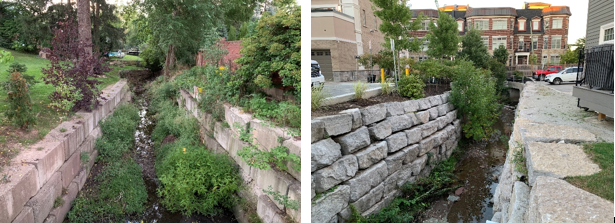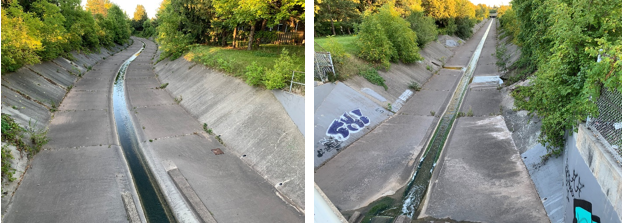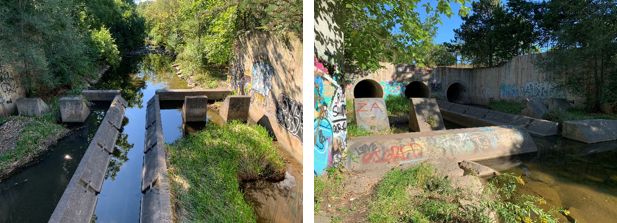 By Eric Chiasson
By Eric Chiasson
September 22, 2021
BURLINGTON, ON
For those of you who live or work in the downtown Burlington area or who enjoy spending time there, you might be familiar with a quiet little creek running through the downtown neighborhoods bringing plenty of small wildlife like foxes, possums, and countless birds and reptiles to our backyards – it is known as the Rambo Creek.
Its headwaters come from north of the QEW passing through several box culverts under the highway and parallels Brant Street to the east zigzagging its way through town to Lake Ontario.

Map of downtown Burlington – alignment of Rambo Creek and Rambo Creek Diversion Channel
It wasn’t always a quiet little creek. There was a time a while back when it would overflow and sometimes flood during big rain falls eroding its banks causing damage in the downtown area. In the 1990’s, however, the Rambo Creek Diversion Channel and its associated flood control structures were built to stabilize the creek and protect downtown from flooding (Hager-Rambo Flood Control Facilities Study Report 2020 – Wood).
Over the past half century Rambo Creek has been getting more crowded with urban development. Parking lots and buildings have been built up against it, and in some cases, right over it! A good portion of the creek is buried in box culverts carrying its waters through town mostly unseen. Following it through town from Highway 403 all the way to its outlet to Lake Ontario near Lakeshore Road and Torrance Street can be challenging because it moves sporadically from forested open creek beds to long underground culverts. It winds between apartment buildings and hides behind strip malls. In some locations, it meanders through residential backyards. If you’re close by and you pay attention, you’ll hear its natural sounds a running water. 
Rambo Creek flowing through downtown residential backyards (left), between buildings and parking lots and diving under roads (right)
Over the years, attempts have been made to stabilize the creek bed by means of concrete retaining walls, gravity stone walls, boulders, and culverts, and have all been subject to significant maintenance and repairs especially during rainy seasons. As much as we try to control water, its damaging affects through erosion are as inevitable as gravity. So, to mitigate the risk of flooding and damage to downtown infrastructure, a diversion channel would be needed to control the volume of water going through Burlington’s historic neighborhoods, which was eventually built in the 1990’s. The channel was funded by multiple levels of government and is maintained and operated by Conservation Halton to reduce the risk of local damage due to flooding (www.conservationhalton.ca/dams-and-channels).
The creek would need to be intercepted high enough to go around the more densely developed downtown area but low enough to maximize the flow reduction through town. And then a less developed route for the channel would have to be chosen. Its starting point would be near the intersection of Fairview Street and Brant Street, and the water would be carried safely southwest to the Hamilton Harbor thereby significantly reducing the volume of water going through downtown.

Rambo Creek Diversion Channel near its starting point next to Fairview Road
The diversion channel today consists of a long concrete paved channel approximately 2.5 km long with steep slopes diverting flows from the Rambo Creek itself, and runs southwest parallel to Fairview then curves south through residential neighborhoods under several roads until it goes under Maple Avenue. This location is one of the best places to watch the channel in action after a big rain fall with deep water being diverted from downtown.
Then the channel runs between Maple View Mall and Maple Park then through a large triple-barrel culvert under the QEW connecting to Indian Creek where a large energy dissipation structure was built to avoid damaging Indian Creek during heavy rains, and flows down Indian Creek’s natural creek bed large enough to carry the water safely to the Hamilton Harbor.
 Downstream end of the diversion channel with energy dissipation structures (beautifully garnished with local artwork)
Downstream end of the diversion channel with energy dissipation structures (beautifully garnished with local artwork)
At any given time, there is always some water flowing through both Rambo Creek and through its diversion channel. During rain falls, however, the volume of Rambo Creek itself increases only slightly accommodating more local runoff form the downtown area, but you’ll notice the flow in the channel increases significantly taking on the majority of the upstream flow from the rains saving downtown from severe damage.
Without this amazing, critical, and unassuming piece of infrastructure, the Rambo Creek would constantly be trying to erode the banks of our historic Burlington neighborhoods. So next time we get a heavy rain fall in the area, thank the Rambo Creek Diversion Channel and the people who built it for keeping the downtown core safe from being washed away.
Eric Chiasson is a civil engineer by training and a construction manager by trade. Having built many infrastructure projects throughout Canada and the United States over the past 25 years he has become a subject matter expert in infrastructure and construction. Eric is driven by his curiosity to learn more about how things are built and how they work, encouraging others to join the ranks of those who design and build the infrastructure that makes living in our cities possible.















There are better ways of mitigating the effects of urbanization on groundwater displacement. Typically used by hired engineering firms are massive concrete pipes, armour stone and gabion stone cages to funnel surges of urban runoff.
Large private developers and land owners (private and public) have pushed back other methods of mitigating storm water rapid accumulation, such as providing significant rain water retention on each property (parking lots and rooftops).
One good way to get rid of the old engineered and earth unfriendly measures is for the municipality to charge for storm water for each property. Fee based incentive here is to put the water where it best for nature and us…into the local groundwaters.
Let’s challenge the Region and City to change those storm water concrete ‘race-tracts’ weaving through our urban areas to a more soft/green and earth friendly.
Thank you for this history of Burlington’s Rambo Creek. It may be of interest to note that on the northern part of this creek major storm culvert repair and replacement is due to bein November 1 and last until April 2022, if all goes well. It will take place where Rambo Creek goes under Upper Middle Road (near Brant). As a local resident I received notice about this project in my mailbox in August, 2021. 536 mature trees and shrubs are slated to be cut down. At the beginning of winter where we live. While the culvert repair & replacement work must be done, and water will flow uninterrupted when completed, I have asked the Mayor and my city councilor for a copy of the arborist’s report, and the environmental assessment to see if we can mitigate the huge number of mature trees being removed… a few of which are on Canada’s federal endangered list and are protected. Perhaps there is a way to spare some trees, because as we all know tree roots help with erosion control and water absorption. It would be terrific to find a way to navigate large earth moving machines in such a way that saves the endangered butternut trees and others. And for those trees that are cut let’s find ways to set up temporary winter shelters for mammals and birds that are displaced by what for them is almost a certain death sentence. Perhaps local high school students might be hired to create cold weather shelters for our wildlife made out of brush, cut shrubs and wood. As climate change impacts us all it is clear that we must also consider the welfare of our wildlife. Trees, the birds, mammals, amphibians, fish, are very much part of what makes Burlington home.